mold removal
Common Areas for Black Mold Growth
In many homes across New York, a hidden menace lurks, ready to cause havoc for residents. This menace is mold and can be found in many different places throughout the home. While mold may seem like something that’s only found in old, damp homes, the truth is that any home can be susceptible to black mold growth.
But before removing and treating mold, you need to know where to look for it. In this article, we’ll take a look at some of the most common places for black mold growth.
What Is Mold?
Mold is a type of fungi that thrives in moist and humid environments. Mold spores are found both indoors and outdoors, and when they land on a wet or damp surface, they can start to grow. While mold is often associated with older homes, it can actually grow in many areas in all types of homes.
Mold can cause several problems for homeowners:
- Mold can cause allergic reactions, including sneezing, coughing, and watery eyes. In some cases, mold can even cause asthma attacks.
- Mold growth can damage your home’s structure, causing rot and deterioration.
- Mold can be difficult to remove, and it often returns unless it’s been properly cleaned and treated.
So, where is mold most likely to grow? Let’s take a look at some of the most common places for mold growth.
Common Areas for Mold Growth Click To Tweet
The Most Common Places for Black Mold Growth
Mold can be found in a number of different places. However, some areas are more susceptible to mold growth in homes throughout New York. These areas include:
The Basement or Crawlspace
A common place to find mold is in the basement or crawlspace. These areas are often damp and humid, which makes them ideal for mold. In addition, basements and crawlspaces are often poorly ventilated, which can further contribute to mold growth.
If you have a basement or crawlspace in your home, periodically inspect these areas. If you find mold, have it removed by a professional mold remediation company.
The Attic
The attic is another common place for mold. Like basements and crawlspaces, attics are often damp and humid due to poor ventilation. In addition, heat from the sun can cause attic temperatures to rise, further contributing to mold growth.
Another common reason for concern is when leaks occur in the roof. Water leaks into the attic can create the perfect conditions for the growth of mold. Be sure to have your roof regularly inspected to ensure there are no leaks and have any leaks fixed immediately.
The Kitchen
The kitchen is a prime area for mold to grow due to the presence of water and food. Black mold loves damp conditions, and kitchens often have a lot of moisture from cooking and dishwashing. Plus, if any of the plumbing isn’t working correctly or you have a leak, this can lead to mold issues.
Where should you look for mold in the kitchen? Check under the sink, around the dishwasher, and in any other area with a water source. Also be sure to keep an eye out for peeling paint or wallpaper, as this can be a sign of a mold.
The Bathroom
The bathroom is one of the most common places where mold can be found. Since bathrooms are used for showering and bathing, there tends to be moisture and condensation in the air. If you don’t ventilate the room properly, mold can start to grow on your bathroom walls, ceiling, tile, grout, and caulk surfaces.
Be sure to check under the sink, around the toilet, and in any other area where there is a water source when looking for mold in the bathroom. If you notice a mildew smell, it’s a good indication that mold is present.
Other Spots Mold Can Hide
While these areas are the most common places for mold growth, mold can actually be found anywhere in the home where there is moisture.
Other common areas include:
- laundry rooms
- garages
- HVAC systems
- Around windows and window leaks
- In air ducts that are damp or have leaks
- On carpets or rugs that get wet or are often damp
- Inside cabinets that are located in damp areas
- Behind wallpaper that is peeling or has water damage
The best way to prevent mold growth is to keep your home maintained, clean, and dry. Be sure to fix any leaks promptly and ventilate damp areas to prevent moisture and condensation from accumulating. It’s a good idea to have your home inspected for mold periodically, especially if you live in an area with high humidity which is prone to mold growth. If you do find mold in your home, be sure to have it removed professionally by a mold removal company as soon as possible.
Signs You May Have Black Mold
There are a few signs that you may have mold. If you notice any of the following, it’s a good indication that you have a mold issue:
1. A musty or mildew smell in your home
A musty or mildew smell is one of the most common signs of mold. The smell of mold is often described as being similar to dampness or wet socks. The smell comes from mycotoxins, which are chemicals that are released by the mold.
2. Visible mold growth
Of course, one of the most obvious signs is when you have visual mold. Mold can often be seen as a black, green, or white fuzzy growth on surfaces. Mold can grow on a variety of surfaces, including wood, paper, carpet, and tile.
3. Water stains or dampness on walls or ceilings
If you notice water stains or dampness on your walls or ceilings, it’s a good indication that you have a leak somewhere in your home. Leaks can provide the perfect conditions for mold to grow, so be sure to have them fixed promptly.
4. Peeling paint or wallpaper.
Another sign of mold is peeling or bubbling paint or wallpaper. While it doesn’t guarantee mold growth, it can be a good indication that there is mold present.
5. Signs of condensation
Condensation can often be a sign of high humidity, which is ideal for mold growth. Do you notice water droplets on your windows or mirrors? This is an indication that the humidity in your home is too high.
6. Health problems
If you or your family members are suddenly experiencing unexplained health problems, it can be a symptom and sign of mold in your home.
These health problems can include respiratory problems, headaches, fatigue, and skin irritation. If you notice any of these symptoms, it’s essential to have your home inspected for mold.
Need a Mold Inspection?
Not sure if you have mold or not? You may need a mold inspection. During a mold inspection, samples from your home are taken for mold testing and then sent to a laboratory. The report and lab results will let you know if you do have a mold: the type, the quantity of the mold spores, the severity of the mold issue, and if you will need mold remediation.
For testing, a mold sample can either be an air test sample using air cassettes, swab sample, or tape lift sample. During the inspection, the technician can advise which test is needed for the mold issue you are having in your home.
Keep Mold Away with a New York Mold Removal Service
Mold can be a small issue that can be resolved by yourself by properly cleaning and removing the areas of mold.
When mold is a bigger problem in your home, you should seek help. Taking action is essential if you think you may have a severe mold problem somewhere in your house. The best way to remove this mold is to hire a professional mold remediation company to assist you.
At Dry Ease Mold Removal, we are New York’s trusted mold remediation service for both residential and commercial properties. We have the experience and knowledge to safely and effectively remove mold.
We also offer a wide range of other services, including water damage restoration, air duct cleaning, and more.
If you think you may have mold in your home, don’t wait to take action. Contact Us Today to schedule a consultation. Our team will work with you to create a customized plan to safely and effectively remove mold from your home.
How Do I Get Rid of Bathroom Mold? Your Bathroom Mold Removal Guide
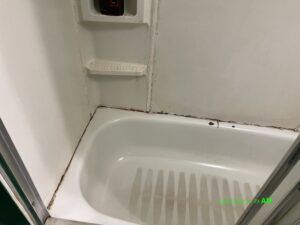
Bathroom mold isn’t something anyone is ever happy to see, but it is common. The bathroom is the ideal breeding ground for mold; it’s damp, warm, and a relatively small space. If you don’t sufficiently air out a bathroom with an extractor fan or by opening a window, that warmth and moisture can cause mold.
The most common areas to find mold in the bathroom is on caulk, grouting, and painted surfaces since it provides a porous surface for the mold to hold onto. Since you’re here, we can safely assume you have found mold in your bathroom, and you want to know how to get rid of it.
The good news is it’s straightforward to remove mold. Read on to learn how to clean the mold in your bathroom and prevent it from happening again.
Can I remove bathroom mold by myself?
Small amounts of mold that grow on caulk, grout, and painted bathroom surfaces can be removed during your normal bathroom cleaning. We’ll guide you through how to remove minor appearances of mold below, but if you discover a larger patch that has been developing for some time, it’s best to contact a Bathroom mold remediation company to remove it for you. Mold can be harmful to your health, especially when disturbed, so do not try to tackle anything that looks like it has been in place for some time.
How do I get rid of mold on grout?
If you’ve noticed some dark spots appearing on your grout, it’s likely little specks of mold. While sealed tile is mold-resistant, grout is not unless it is sealed regularly. If there’s just a little mold and your grout is white, you can use a simple bleach or white (distilled) vinegar solution to spray and rub away the mold. If it does not simply wipe away, you can leave it to sit for up to 30 minutes and use a small brush to scrub it away.
If you have colored grout, it’s best to speak to bathroom mold removal specialists as using bleach, vinegar, or baking soda may make the color fade, and so it’s best to seek specialist advice.
How do I remove bathroom mold from a painted wall?
If mold has grown on painted or wallpapered surfaces in your bathroom, you’ll need to be careful. You cannot use bleach, but some lightly diluted white (distilled) vinegar can be effective. Simply spray or wipe some of the solution over the mold and it should come away easily.
If your bathroom has been decorated with bathroom paint, this will be easier, but matt paint and luxury wallpapers can prove more of a challenge. If you’re not sure, a bathroom mold removal company can advise you.
How do I prevent bathroom mold?
- Use your bathroom extractor fan or open a window as you shower, or immediately after if it’s too cold
- If you have a shower curtain, pull it out straight (so it’s not bunched up) after showering so it can dry efficiently
- Make sure towels are hung up and can dry properly
- Wash towels, mats, and your shower curtain regularly
- Make sure your faucets don’t have a leak (even a constant drip can make the room more humid)
- Reseal your grout once a year
- Repair/replace caulking that’s no longer effective
- Paint over walls that have normal paint with special bathroom or kitchen paint, as it’s designed to be water and mold resistant
General Tips for your Bathroom
Proper ventilation in bathrooms is vital to lowering humidity. Besides piping systems behind the walls in the bathroom, showering and general sink use creates elevated humidity which can be a breeding ground for mold and create a mold condition. Extraction fans should be installed in bathrooms, you typically need a one-inch fan for every 100 sq. ft of bathroom space. Backsplashes and tubs should be recaulked and regrouted every 18 months regardless of the deterioration of the sealant of backsplashes. Building materials used for bathrooms should exclusively be cement board, tile, and grout. Ultimately, framing of the bathroom should be used with metal studs not wood 2 x 4’s. Once a leak has been identified, and sheetrock has been affected by water damage in a bathroom, it should be immediately replaced. Once sheetrock has been affected by water damage, as it dries, it becomes more porous. Porous building materials are a breeding ground for mold growth.
A mold inspection and testing are recommended when you are not sure if you have mold, especially if you can’t see it. It may be in your bathroom behind a wall, inside the ceiling, or in an area that you can’t get to or see, you should contact a mold professional to help you.
CLICK HERE for a Bathroom Mold Inspection
Bathroom Mold Removal in New York
If you’ve found mold in your bathroom and it’s unsafe to handle alone or is in a difficult-to-reach area, we’re here to help. We’re mold remediation specialists in New York and will remove bathroom mold safely from your home or place of work, ensuring the health of everyone inhabiting the building. To find out more, click here.
How Do I Get Rid of Bathroom Mold? Your Bathroom Mold Removal Guide Click To Tweet
Found Mold in Your Basement? Here’s What You Should Do Next
Unless your basement is beautifully finished, it is a room that is often neglected and rarely ventured into, which puts it at particular risk of becoming damp. This moisture that can sit in your basement unnoticed provides the perfect conditions for mold, a fungus that can cause musty smells and is harmful to respiratory health.
Today we’ll guide you through how to identify dampness in your basement, what to do if that dampness has created the right environment for mold, and how to get rid of it.
How do I know if my basement is damp?
There are a number of signs that will indicate your basement is damp, including:
- visible mold or mildew covering the walls and floor
- particularly cold and wet feeling walls
- a powdery deposit on the walls and floor
- damp along the base of the walls, expanding upwards
- peeling paint and wallpaper
- high levels of condensation on the basement windows
- loose or wet tiles, carpet or vinyl
What causes mold in basements?
Mold in basements is caused by moisture, whether that be direct contact from water or excess moisture in the air. More specifically, here are the most common causes of mold in basements:
1. Condensation:
Since the basement temperature is usually much lower than that in the other rooms of your home, condensation often forms. Cold air is unable to hold a lot of moisture and so condensation will occur on the basement windows and walls if warmer air is allowed to flow into the basement. The moisture from the condensation creates the perfect conditions for mold to grow.
2. Leaking pipes or cracks in the walls:
If you don’t notice or fix a leaky pipe, water can often flow freely into the basement, causing it to become damp. Since leaks can be minor, a little damp can go unnoticed for days or weeks if the basement is unused. Similarly, a crack in the foundation or outer wall can allow moisture to enter the basement, providing the right environment for mold to form on the walls and floor.
3. Poor waterproofing:
If you live in an old house or your basement was not waterproofed properly, moisture can make its way into your basement, through the foundations, from the ground below or surrounding the basement walls
4. Unused plumbing:
If you have a sink or bathroom in your basement that is rarely used, it can cause problems. While you may only use it once a week or so, the water sitting in the pipes can seep out over time, allowing moisture to build up in the basement.
5. Laundry:
Your basement may be a convenient place to do your laundry, however, a lot of the moisture from washing and drying your laundry will be released into the basement itself and if you don’t use a dehumidifier or if it doesn’t get enough air circulation from your HVAC system, moisture can accumulate, especially behind your washer and dryer.
What should I do if I find mold in my basement?
If left untreated, not only will the build-up of mold in your basement result in an unpleasant, musty odor and potentially damage your belongings and home, but it can also be harmful to the health of your family and pets, particularly if someone suffers from asthma or any other respiratory-related issues.
Additionally, if you are planning to sell your home soon, a damp, moldy basement will drastically harm your ability to find interested buyers.
In most cases, if you find mold in your basement, you should call in a professional basement mold removal service, like Dry Ease in New York, to find the cause of the dampness in your basement and safely remove all the harmful mold.
How much does basement mold removal cost?
The cost of basement mold removal depends on the extent of the mold, how it needs to be treated, and the size of your basement.
Typically, mold removal will cost a minimum of $500, depending on whether the mold needs spraying or scraping, whether a high-efficiency particulate air filter (HEPA) vacuum needs to be used, or encapsulation is necessary, or a combination of treatments.
According to HomeGuide, spraying costs $1-$9 per cubic foot, scraping costs around $1.25 per square foot, a HEPA vacuum costs $0.90 per square foot, and encapsulation costs anywhere from $5 to $79 per cubic foot.
If you’re in New York, Contact Us and one of our basement mold removal experts will be able to advise you and give you an accurate quote based on your specific circumstances.
How do I prevent mold from growing in my basement?
Luckily, there are several ways in which you can help to prevent mold from growing in your basement, all of which work to reduce the level of moisture – the direct cause of mold. Here are some of our top tips:
- The next time it rains, identify where rainwater flows when it falls from the roof. If it looks like it is working its way towards your basement, it is a good idea to have the area around your home landscaped to that the ground slopes away from the exterior walls, allowing any water to flow away.
- Take the time to inspect the windows of your basement to make sure they are sealed properly as well as ensuring that any window wells are allowing for proper drainage.
- It is also important to regularly clean out your gutters so that water can flow properly and is not simply overflowing out of the gutter before reaching the downpipe. Also, make sure that the downpipe forces water well away from your house.
- If your basement doesn’t already have them, it is crucial that you have proper air ventilators installed and open the windows regularly for as long as the weather allows. If you live in a particularly humid area, you will most likely need to add a dehumidifier to your basement to prevent air moisture from building up.
- You should also ensure that the pipes running through your basement are correctly insulated to prevent condensation from building up on the outside of the pipes, due to temperature differences.
- It is also helpful for you to dry your laundry outside whenever it is possible. That way, the moisture from your clothing will be expelled straight into the air rather than absorbed into your basement walls.
- Consider if your basement may need reproofing.
DIY Solutions for Removing Mold in your Basement
If you have mild to moderate mold in your basement, you can clean it by yourself if the affected area is no larger than 10 square feet. You can use a household product like vinegar, baking soda, or hydrogen peroxide and mix it with water. Carefully apply your mixture onto the floors, walls, and affected area and let it sit on the moldy area for about 10 minutes, then scrub and clean. After cleaning the area, make sure to completely dry the area. If possible, make sure to ventilate the area while cleaning by opening a window or running a fan while cleaning. Also always wear gloves, a face mask, and protective clothing.
If you have a bigger mold issue, you should hire a professional mold remediation company. They will sanitize and wipe all affected surfaces with antifungal and antimicrobial products. They also use HEPA air scrubbers, HEPA vacuums, and dehumidifiers to properly clean up the mold and mold spores in your basement. They will set up full containment so that the rest of your house does not get contaminated. Remember by hiring a professional, they will give you peace of mind knowing they have the expertise and training to properly remove mold. Hire a mold INSPECTOR HERE
Basement Mold Removal in New York
If you find or suspect you have mold in your basement, contact a mold removal expert. It’s important to have the mold removed safely, without putting anyone at risk, and to find out what caused the mold in the first place so you can put it right.
If you’re looking for basement mold removal in New York, we’d love to help. With Dry Ease, you can be sure that your basement mold will be inspected and treated by professionals safely and thoroughly to ensure that any harmful mold is expelled from your home.
Found Mold in Your Basement? Here’s What You Should Do Next Click To Tweet
Found Mold in Air Ducts? Here’s Why, How to Remove It & Prevent It
Have you been away for a few days and come home to find your home smells musty? A strange smell is the most common early warning sign that you have mold in your HVAC system, but it can be easy to overlook.
We all get used to the smell of our homes so it can take leaving for a few days, the words of an honest friend, or noticing a difference in smell when your HVAC system is on or off to realize your home smells… well, moldy.
The good news is that if the musty smell is coming from mold in your air ducts, HVAC mold removal is a straightforward process. Read on to learn how it got there in the first place, ways you can get rid of it, and how to prevent it from reoccurring.
How do I know if there is mold in the air ducts?
Here are some common signs of mold in air ducts:
Smell
As we touched on above, a musty or strange smell is a common sign. You may notice the smell fluctuates as your HVAC system powers on and off.
Discoloration around air vents
If you notice some darkening or discoloration around your air vents, it may be mold. It’s also worth shining a torch inside to see if you can see any visible signs of mold inside your air ducts.
Check your drip pan
The drip pan collects moisture that’s pulled out of the air, so any blockage can create the right environment for mold to grow.
Allergic reactions at home
If someone in the home suffers from seasonal allergies or has a respiratory issue (such as asthma), they may find their symptoms are worse while in the home than in another environment. If the mold in the home is bad, or one that’s particularly harmful, it can even make people with no existing respiratory issues sick with feelings of dizziness, headaches, and nausea.
Note that you don’t always need to be able to see mold for it to be there. Spores in the air may be coming from an area you can’t see. It’s also worth checking other high-risk areas of your home if you’re not sure where the mold is, such as bathrooms, laundry rooms, garages, basements, and attics.
Why has my HVAC system got mold?
Mold needs just three things to grow: a habitable surface (a porous material), a little warmth, and some moisture. If mold spores find these three things, and there’s little in the way of airflow, it will grow quickly. That said, if your HVAC system is well maintained and working correctly, there shouldn’t be any opportunity for mold growth. Here are some of the most common reasons why mold may be growing in your HVAC system:
You’re setting your A/C too low
If you regularly keep your AC at a warm temperature to save on your energy bills but crank it down to sweater weather when you get home, you may be creating unnecessary moisture. When the cold air and warm air meet, the moisture in the warm air may collect on surfaces near the vents. This generally has to be quite an extreme temperature change (say, walking into your home at 82F and setting your thermostat at 62F), but it does happen.
Your AC is too big for the space
An AC unit that’s too small for a space will merely leave a room too warm, but one that’s too big can cause problems. While you feel cool and comfortable, the AC may not be running for long enough to effectively extract moisture from the air, allowing it to collect and provide the right environment for mold growth.
You have a leak
If you have a small leak in a water pipe in your home or you have a leak in your air ducts, it may create the right conditions for mold. A small leak in a water pipe may mean it’s slightly too damp in your home for your AC unit to sufficiently pull moisture out of the air. Equally, having a duct with a leak will allow warm air in, causing condensation where the warm and cool air meet.
How do I remove mold from air ducts?
If your HVAC system has mold, it’s a simple fix, but it does require the expertise of an HVAC mold removal professional. It’s not enough just to spray the areas with a bleach solution and go about your day – there’s a reason why mold is growing, and it needs to be found and treated. Mold can also grow in areas you can’t see, which must be dealt with by an HVAC Mold Remediation Specialist.
HVAC Mold Removal Specialists have the right equipment to remove the mold entirely, without putting your family or themselves at risk.
If you’re in New York, we’re here to help. Our HVAC mold removal technicians use video inspection equipment with our specialist cleaning equipment to cleanse your air ducts of mold.
To learn more about our HVAC Mold Remediation Services, CLICK HERE
How do I prevent mold from growing in my HVAC system?
Once you’ve had your HVAC cleaned (and if necessary, fixed), you’ll want to keep it running smoothly to prevent mold from growing again in the future. The best way to prevent getting mold in your HVAC system is to get regular services and cleans – getting your HVAC system serviced regularly will ensure everything can work as it should and having scheduled cleans will ensure you stay mold-free.
This is an especially good idea if your home is humid (common for those keeping fish tanks, houseplants, and reptiles), you deal with recurring mold (more common in older homes), you live in an area with high humidity, or if someone in the home has a respiratory problem.
Why a Mold Inspection and Testing is Important?
Mold in your home can be harmful and dangerous especially if you have a baby, children, or someone who is immune-compromised or has respiratory issues. If you think you might have mold, it is worth spending the money to have a professional come to your home and do a mold inspection and mold testing. It is important to do the research and find a reputable mold inspection company. They will come to your home and inspect the areas with the mold issue. The technician will determine where and how many tests should be taken. They will take an air sample, swab sample, or tape sample. It is sent to a laboratory for comprehensive results. Within a week, you will be given a mold report and lab results.
Click here to learn more about a Mold Inspection in the New York area
When testing for mold in the HVAC, air sample testing is usually recommended since it is the best way to find out if you have a mold issue. Air sampling captures a volume of air and measures the contaminants in it. You should hire a qualified professional mold removal company to do mold testing at your home or workplace.
Click here to Book a Mold Inspection with a certified Mold Remediation Company
If the laboratory results show that you have mold or mold in your ducts, you should consult a remediation company. It is possible to DIY but it is time-intensive and you need to make sure it is properly removed or it can come back. It may be better to hire a remediation company who have the training, expertise, and knowledge about effectively removing mold at your home or commercial building. They will use commercial-grade chemicals, products, and equipment that you may not have.
Found Mold in Air Ducts? Here’s Why, How to Remove It & Prevent It Click To Tweet
HVAC Mold Removal in New York
When you suspect you have mold in your home or at work, mold in your HVAC system, or have found significant evidence of it, our experienced team is here to help. Our HVAC Mold Remediation Services ensure NYC households stay mold-free and keep you healthy, and breathing easily.
To Find Out More, CLICK HERE or to Book an Appointment, CLICK HERE.
MOLD REMOVAL & HEALTHY HOMES NYC (2022)
Ways to make your home a healthy living space and avoid costly mold removal services.
What is Mold?
Molds are present and a part of our natural environment. In the outdoors, molds are in nature by breaking down dead organic matter like dead trees and fallen leaves. But for the indoors, mold growth should be avoided. Molds will reproduce through tiny spores; the spores are invisible to the naked eye and float throughout indoor and outdoor air. Mold can start growing indoors when mold spores land on wet surfaces.
Every house and every environment has mold spores, so it is impossible to get rid of all mold and mold spores indoors. It is normal for some mold spores to be found floating through the air and in house dust. It can become an issue and dangerous when the concentration of mold spores in a home is greater than what is found outside. Remember, there are three conditions needed for the various types of molds to thrive: an ideal temperature, a source of food, and moisture.
Is Mold Making You Sick? Click To Tweet
Is Mold Making You Sick? (Health Issues)
There is an estimated 100+ species of mold known to cause illness in humans. People who have exposure to the mold sometimes experience dermatitis, coughing, allergic reactions, asthma, nasal problems, infections, or respiratory complaints.
Some molds produce mycotoxins which are toxic substances produced by fungus. The term “toxic mold” refers to molds that produce mycotoxins such as Stachybotrys chartarum, which can pose serious health risks to humans and animals. When exposed to high levels of mycotoxins, some studies claim it can lead to neurological problems and in some cases even death. Therefore identifying mold damage should be done by a Mold Inspector. Once the severity of the issue is identified, hiring a professional Mold Remediation Company will be a good option to properly handle a mold infestation.
Water Damage & Mold Prevention in a Home
Humidity control is the most important factor in preventing mold growth. Whether it be your basement or attic, humidity control is key. You may purchase a humidity gauge to monitor humidity. Humidity should not be above 55% on average. Every basement in the U.S.A. should have a dehumidifier and a humidity monitoring system. Getting rid of black mold can be an uphill battle if humidity is not controlled. Ventilation in your property is also very important in mold prevention. Mold Removal Services in New York may be needed once moisture control in systems are compromised.
If there is mold growth in your home, clean up the mold and try to fix the water problem causing the growth. You should look for mold damage throughout the home after hurricanes and floods. If you clean up the mold but don’t fix the problem, the mold will most likely come back. Basement mold can be found on the foundation floor and interior foundations.
Mold growth occurs from the following:
-Leaks & Damage (Plumbing, Roofing, HVAC)
-Rain, Floods, Hurricanes
-High Interior Humidity
-Poor Ventilation
-Build-up of Condensation
HAVE A MOLD ISSUE? Contact us today.
Factors in Moisture Control
There are many factors that affect moisture in your basement.
One of the things that should be looked at is foundation issues. Foundation issues may contribute to moisture intrusion. The soil grade of your exterior home can play a factor as well. If the soil grade is insufficient surrounding your foundation, rainwater will seep into your basement. Rain gutters also are key factors of moisture intrusion in your basement. Gutter leaders that are too close to the home will affect the excess water surrounding your foundation. Your home’s siding should be maintained properly. A formal mold inspection should be implemented once a visual leak in the foundation occurs. If there are any gaps or cracks in the building’s siding, moisture will also seep into the structure and cause mold damage. Properly installing dehumidifiers into your basement is vital to extract any moisture.
Types of building material used in the basement are important to consider as well. Using non-cellulose building material is an essential way to prevent black mold growth. Rigid insulation and cement board are some examples of these materials. Floor tiles are highly recommended for basements throughout the United States. Installing wood or carpet in a basement is not recommended as it will absorb any moisture. Moisture and mold prevention in a basement is vital when your home’s HVAC system is in your basement. If there are mold spores in your basement, near your HVAC system, the system will intake the spores and contaminate your home. If you need to hire someone, it is important for homeowners to do stringent research in finding a suitable company that offers Mold Inspection and Testing. Also, do some research since there are a limited amount of Mold Removal Companies in New York that can remediate the mold in HVAC systems.
When purchasing your home, it’s important to look at the water table surrounding your property. Properties with high water tables are at higher risks for elevated moisture intrusion events, high humidity, and mold growth.
Sprinkler systems too close to the property’s foundation will contribute to water intrusions and increases the possibility of needing mold remediation services. Monitoring sprinkler systems by a professional is recommended seasonally.
Mold Prevention in Attics
The main factor to avoid moisture and mold in the attic is having sufficient ventilation. Attic soffits should be unobstructed as well as baffles should be installed at the roof’s ridge. Extraction fans are vital if the attic does not have static ventilation systems. The extraction fan in an attic can be installed using a temperature or humidity gauge. Once the temperature or humidity of the attic has reached above 55% or 80 degrees, the fan will turn “On”. Insulation should never be installed on the interior of the attic opposite the roof tiles. Maintenance and upkeep of a bathroom extraction fan ducting should be done seasonally. If extraction fans are displaced and are exhausting into the attic, the humidity will increase and cause moisture and mold growth.
Landscaping is also a factor in preventing moisture to your foundation. Shrubbery too close to the property will prevent the drying of the soil near your foundation. Shrubbery can also grow into your building’s exterior façade. Trees too close to your property can grow roots into your foundation causing cracks in your home’s foundation. Also trees too close to the property can grow into your exterior façade causing leaks and mold growth. Seasonal tree trimming is recommended to avoid water damage on your property.
Getting Rid of Mold
With some household products, you can create a DIY mixture for mold removal in small areas. Always wear rubber gloves to protect your hands and a N-95 face mask.
- Undiluted white vinegar can be used on hard surfaces including kitchens and bathrooms.
- Mix one cup of bleach with a gallon of water, apply it to the affected surface, and do not rinse.
- Make a 50% ammonia and 50% water mixture. Spray it on the surface and wait two to three hours and then rinse.
NOTE: Never mix ammonia with bleach or other all-purpose cleaners together, it can be toxic and create dangerous fumes.
Mold Removal Company Options
Choosing a good company in the New York area can take some research and time.
You can Contact Dry Ease Mold Removal NY for a free consultation and questions about mold.
Mold Inspection Company Options
Choosing a qualified Mold Inspection Company comes down to the experience of the individual technician as well as the laboratory they use to identify the mold spore counts. Black mold testing is an important part to identifying the scope of mold and air quality. You may contact our affiliated company – Prime Aire Mold Services with any questions about your Mold Inspection. HERE

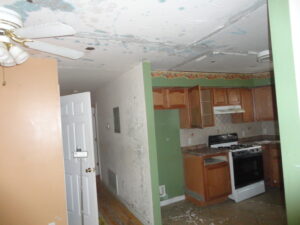
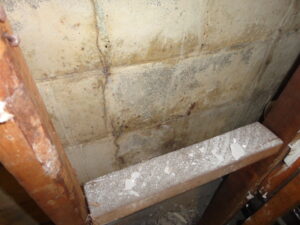

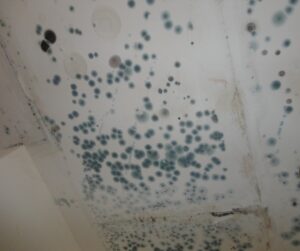
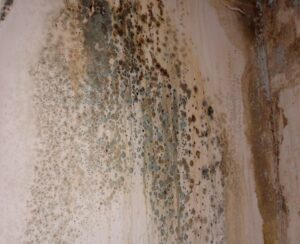
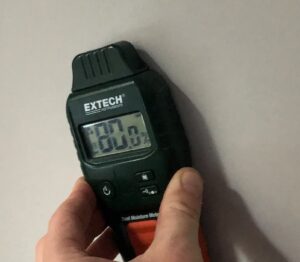
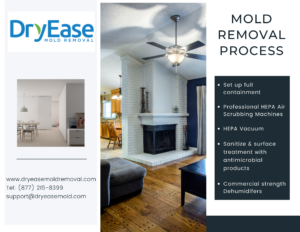
Recent Comments